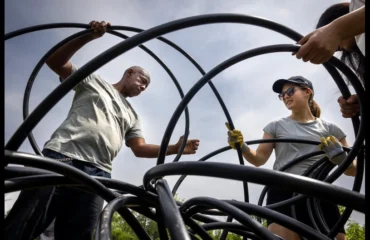University awarded $53M to expand Great Lakes research
The University of Michigan has been awarded a five-year, $53 million renewal agreement from the federal government to continue and expand the Cooperative Institute for Great Lakes Research, with the goal of helping to conserve and manage the region’s natural resources.
Since 1989, the National Oceanic and Atmospheric Administration has awarded eight consecutive multiyear cooperative agreements to U-M to help the federal agency accomplish its mission in the Great Lakes region.
The Cooperative Institute for Great Lakes Research is hosted by the School for Environment and Sustainability and the new $53 million renewal, which more than doubles the funding level of the previous five-year period, is the largest sponsored award in the school’s history.
CIGLR scientists and their students work alongside researchers at NOAA’s Great Lakes Environmental Research Laboratory in Ann Arbor to seek solutions for some of the most pressing Great Lakes issues, including a changing regional climate, extreme weather events, invasive species, harmful algal blooms and ecosystem protection.
“I look forward to continuing our work with GLERL,” said environmental microbiologist and CIGLR Director Gregory Dick, a professor of earth and environmental sciences, and ecology and evolutionary biology in LSA, and a professor of environment and sustainability in SEAS. “The renewal of our cooperative agreement will allow us to expand our research to meet key scientific challenges in the Great Lakes.”
CIGLR employs 42 people at its Ann Arbor-based research institute. Twenty additional employees — including technical staff, postdoctoral researchers and faculty research scientists — will be added in the coming year, according to program manager Mary Ogdahl.
Under the terms of the renewal agreement, which takes effect July 1, U-M will make its strongest-ever financial commitment to CIGLR, more than tripling its previous funding level to $3.6 million over five years and pledging additional in-kind support.
In addition to the research institute, CIGLR leads a regional consortium of universities and private-sector partners. Under the funding renewal, Lake Superior State University will become the 10th university in that regional consortium.
The addition of the Sault Ste. Marie-based university will facilitate collaborations with the new, congressionally mandated U.S. Coast Guard National Center of Expertise for the Great Lakes, which will conduct research on the impacts of, and responses to, oil spills. The center will be co-located at Lake Superior State and GLERL.
“I’m very excited about the renewal for the Cooperative Institute for Great Lakes Research,” said GLERL Director Deborah Lee. “We are pleased to be continuing and expanding our great collaborative research on priority issues such as how climate change is affecting the Great Lakes Region, addressing harmful algal blooms and invasive species, and strengthening the region’s economy and resilience.”
CIGLR’s main goal is to recruit, train and retain highly qualified research scientists and scientific staff to work alongside researchers at GLERL. Over the course of the previous five-year cooperative agreement, the U-M-led institute provided career training to more than 250 students and postdoctoral researchers at 33 institutions.
During that time, CIGLR funded $10.3 million in collaborative research and programs that connected NOAA to 22 universities, businesses and nongovernmental organizations across the Great Lakes region.
The interdisciplinary breadth of CIGLR’s research program is evident from the list of the co-principal investigators at U-M. That list includes three aquatic ecologists, an environmental chemist, an engineer, an atmospheric scientist, an expert on coastal planning and management, a toxicologist, and three social scientists from environmental policy, environmental history and climate adaptation.
“I am thrilled to join CIGLR and to lead the renewal and expansion of our work in social science and environmental policy,” said Sara Hughes, associate professor of environment and sustainability at SEAS and incoming CIGLR associate director. “We have a lot of work to do in addressing inequitable impacts of climate change — such as those from flooding — on communities throughout the Great Lakes and supporting investments for the future.”
Over the next five years, one key area of focus for CIGLR and GLERL scientists and engineers will be the further development of autonomous monitoring systems — stationary and mobile — for the Great Lakes.
The stationary platforms include nearshore observing buoys and underwater autonomous laboratories called environmental sample processors. ESPs currently monitor harmful algal blooms in western Lake Erie, measuring toxins and collecting genetic information about the cyanobacteria that produce them.
One of the mobile observing systems under development will integrate a third-generation ESP into an uncrewed surface vehicle capable of sampling at multiple depths. The vehicle would be operated in coordination with a drone that uses hyperspectral cameras to discriminate nearshore harmful algal blooms by their color.
The project is a partnership between CIGLR, several NOAA centers and labs, Louisiana State University and the Monterey Bay Aquarium Research Institute.
In February, CIGLR scientists and colleagues from more than a dozen U.S. and Canadian institutions participated in the first-ever coordinated winter sampling campaign of all five Great Lakes, known as the Winter Grab. In the coming years, CIGLR will continue to support efforts to develop a permanent Great Lakes winter-sampling program.
In one longer-term effort to expand the capacity for winter observations, CIGLR proposes to work with GLERL and the U.S. Geological Survey to develop an autonomous under-ice vehicle to measure environmental conditions and the distribution and abundance of important food-web components: zooplankton, tiny shrimp-like crustaceans called mysis, and plankton-eating fish.
“This new cooperative agreement will enable us to work with partners to expand our capacity for conducting observations in the winter, when there are large knowledge gaps in our understanding of key ecosystem processes,” said Russ Miller, CIGLR’s research theme lead for observing systems and advanced technology. “Application of autonomous and remote sensing technologies will provide insight into important food web components and how they respond to a changing climate.”
Over the past five years, major research accomplishments by CIGLR researchers and their NOAA colleagues include the development of:
- The 3D HAB Tracker to track harmful algal blooms in Lake Erie. The tracker has been operated by NOAA since 2020 and is now the NOAA Lake Erie Harmful Algal Bloom Forecast.
- An experimental forecast that predicts the location and movement of low-oxygen water in Lake Erie’s central basin, providing advance warnings of these “hypoxic upwelling events” to public water systems.
- New tools and improved models to provide National Weather Service forecasters with more accurate lake-effect snow, precipitation, and ice forecast guidance.
- Genetic data that highlights the tremendous genetic diversity of Microcystis, the group of freshwater cyanobacteria responsible for harmful algal blooms in Lake Erie, Lake Huron’s Saginaw Bay and elsewhere.
- Survey data that showed how quagga and zebra mussels, a major Great Lakes invasive-species concern, critically impact Lake Michigan and act as the main biotic driver of ecosystem change.
“A central part of our mission is turning science into action by engaging with stakeholders in the co-design of research and the development of research products,” said CIGLR’S Ogdahl. “As Great Lakes communities face challenges from climate change, invasive species, and pollution, this engagement is more important than ever.”
More Information:


